Study shows both MPAs and the MacKay Principle in marine ecosystems through a sparing/sharing framework have merit depending on the seascape ecological and social context
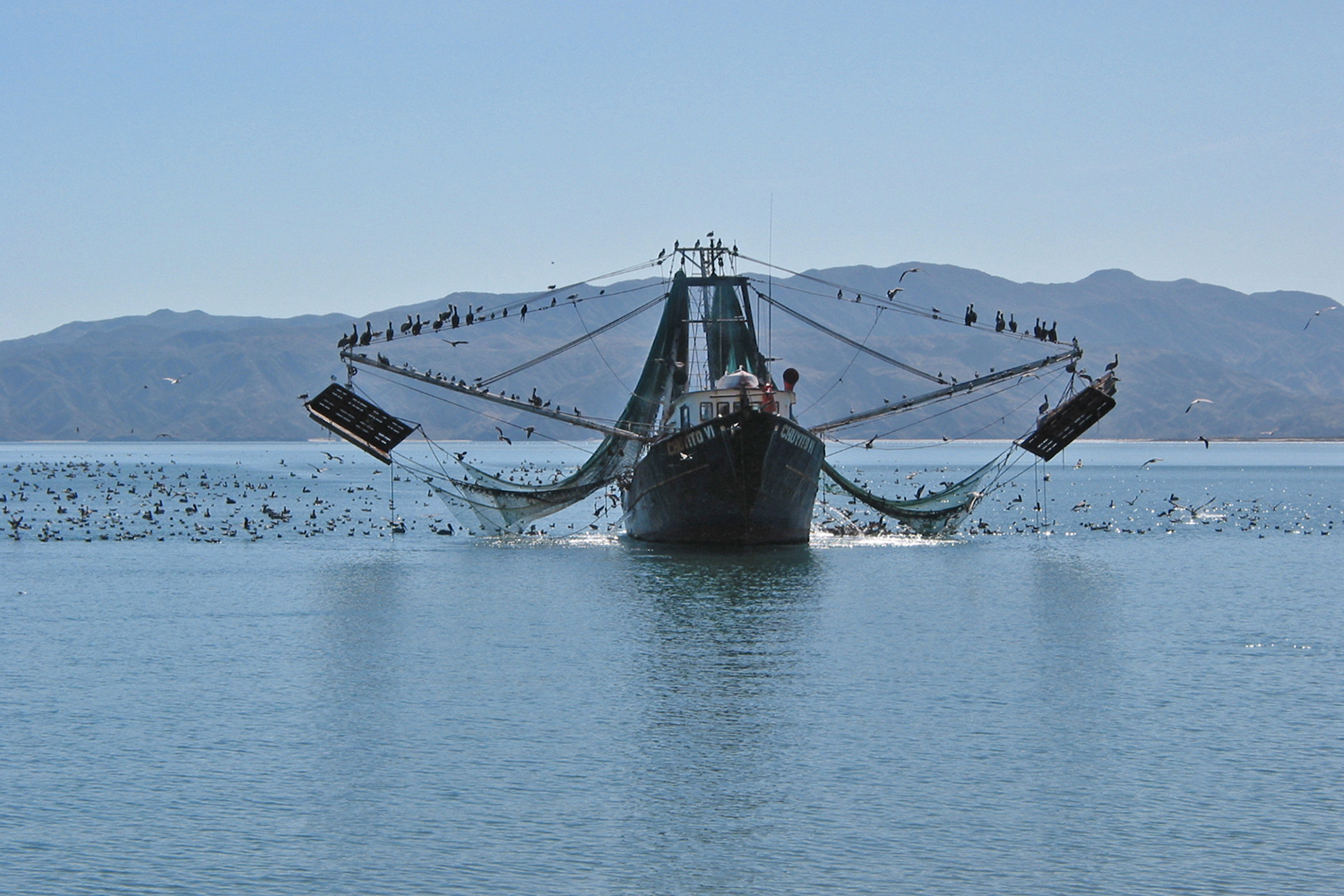
Sustainable fisheries are vital for global food security, but the direct and indirect impacts of fishing pose among the greatest threats to marine biodiversity. Although a wide range of solutions for reconciling marine conservation with demand for wild-caught fish have been proposed, two approaches are particularly prominent. The first is conventional fisheries management, in which managers control seascape-wide fishing effort using tools like total allowable catch limits to regulate the impacts of fishing on both targeted and non-targeted species. The second is the establishment of marine protected areas (MPAs), which, in their most restrictive form as no-take MPAs, exclude fishing from some proportion of the seascape entirely.
Several analyses suggest that MPAs may benefit both conservation and fisheries objectives in overfished seascapes. However, criticisms have been leveled against their use in seascapes in which fisheries are already considered to be ‘well-regulated’ by traditional standards of fisheries management (i.e., where targeted species biomass exceeds minimum sustainable limits and fishing mortality does not exceed maximum sustainable limits. Together, these have been used to question the efficacy of MPAs in some of the contexts in which they are presently deployed.
One potentially productive approach is adapting an influential model from agriculture – the land sparing/sharing framework, known as the MacKay Principle, which asserts that “evaluations of contrasting approaches to meeting demand can only be made by comparing outcomes across alternatives that are matched in terms of total production” – to an archetypal managed trawl fishery to determine how catches can be obtained at least cost to biodiversity in such seascapes. This new sea sparing/sharing framework fixes catch across scenarios so that fishing effort displacement is not overlooked.
In the context of conventional fisheries management and MPAs, this means that alternative management approaches to meeting demand can only be meaningfully assessed using scenarios that produce the same total amount of catch. If the establishment of an MPA means that fishing effort intensifies in the remainder of the seascape to maintain pre-MPA catch levels, then the impact of that displacement on biodiversity beyond the MPA must be accounted for.
This article – summarized from the original publication (Erm, P. et al. 2023. The biodiversity benefits of marine protected areas in well-regulated fisheries. Biological Conservation Volume 284, August 2023, 110049) – reports on a study to develop a sparing/sharing model for fisheries to determine what balance of MPAs and fishing effort regulation minimizes biodiversity loss for any given catch of a targeted species in a highly-regulated fishery.
Study setup
To apply the MacKay Principle to the more general problem of fisheries and biodiversity, we develop a sparing/sharing model for fisheries to determine what balance of MPAs and fishing effort regulation minimizes biodiversity loss for any given catch of a targeted species in a highly regulated fishery. We apply this framework to a trawl fishery to evaluate biodiversity impacts on a suite of plausible assemblages of benthic species constructed from trawl impact data. We then derive several analytical rules for the conditions under which species in highly regulated seascapes are likely to benefit from MPAs and use one of these to assess what proportion of well-regulated crustacean trawl fisheries worldwide may gain from establishing no-trawl MPAs.
For detailed information on the model development, application and analyses, refer to the original publication.
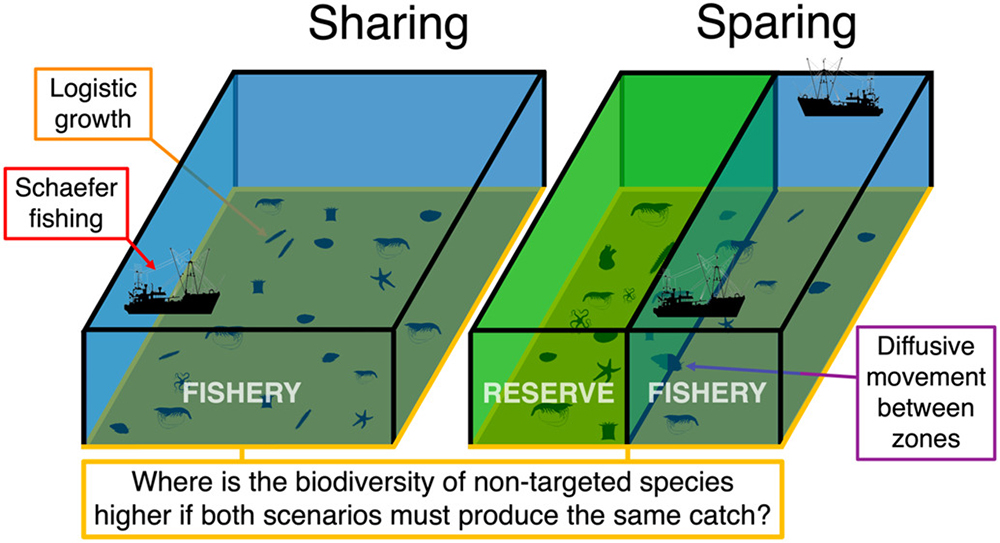
Results and discussion
The sparing/sharing framework has been useful in establishing how terrestrially derived food might be produced with the least cost to biodiversity. In invoking the MacKay Principle, it deliberately matches production outputs across scenarios to facilitate like-for-like comparisons. In our study, we adapted the framework to a non-overfished capture fishery to determine what fraction of a seascape might best be allocated to MPAs for biodiversity conservation without compromising catch.
Our results showed that the ideal strategy depends heavily on the sensitivity of non-targeted species to fishing effort and the biodiversity metric used. If there are species in the seascape that are highly vulnerable to fishing, which we find to be likely in our species assemblages, and if a metric is used that is sensitive to their possible extirpation, then a sparing approach combining effort control and an MPA offers the most promise for obtaining catches at the lowest cost to biodiversity. If such vulnerable species are absent, or if a metric insensitive to extirpations or low species population sizes is used instead, then a sharing approach utilizing effort control alone produces the best biodiversity outcome.
Our core finding – that effort control with an MPA will produce the best biodiversity outcome in a seascape where sensitive species exist whose protection is a priority, even accounting for the displacement of fishing effort by the MPA – is evident regardless of the presence or amount of dispersal between the fished zone and the MPA. The precise proportion of seascape reserved that delivers the highest biodiversity does change markedly across catch targets and assumptions, however. Establishing an MPA also always results in more total fishing effort being required to reach any given catch target as well as reduces the maximum achievable catch target. Our framework thus suggests that the best strategy in a given seascape will depend heavily on the incidence of vulnerable species there, and the conservation and management priorities of its stakeholders.
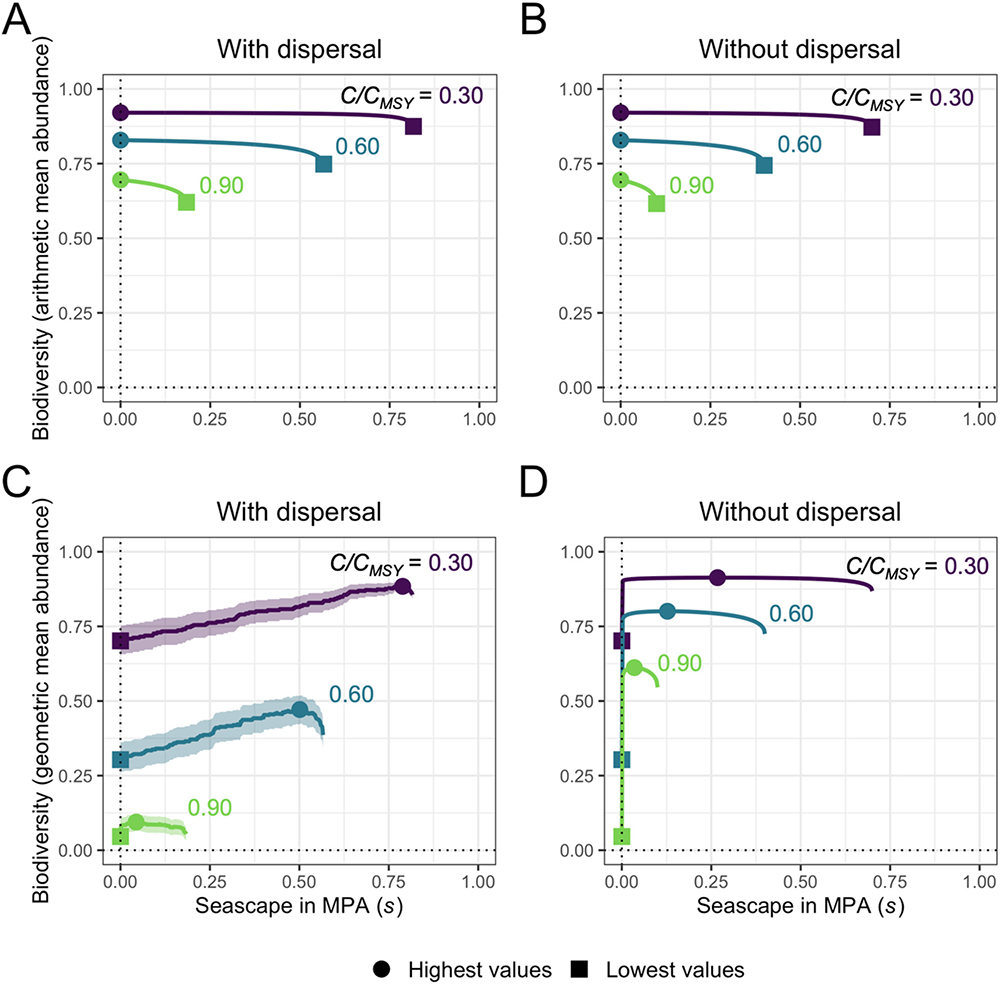
Moreover, the values we drew on to construct our synthetic species assemblages were derived from studies overwhelmingly conducted in recent decades, and therefore in seascapes whose ostensible baselines may have long ago shifted. That these communities appear resilient to trawling at the class level may arise because highly sensitive species have already been driven locally extinct; indeed, there is evidence that the composition of trawling catches has changed substantially over the past century.
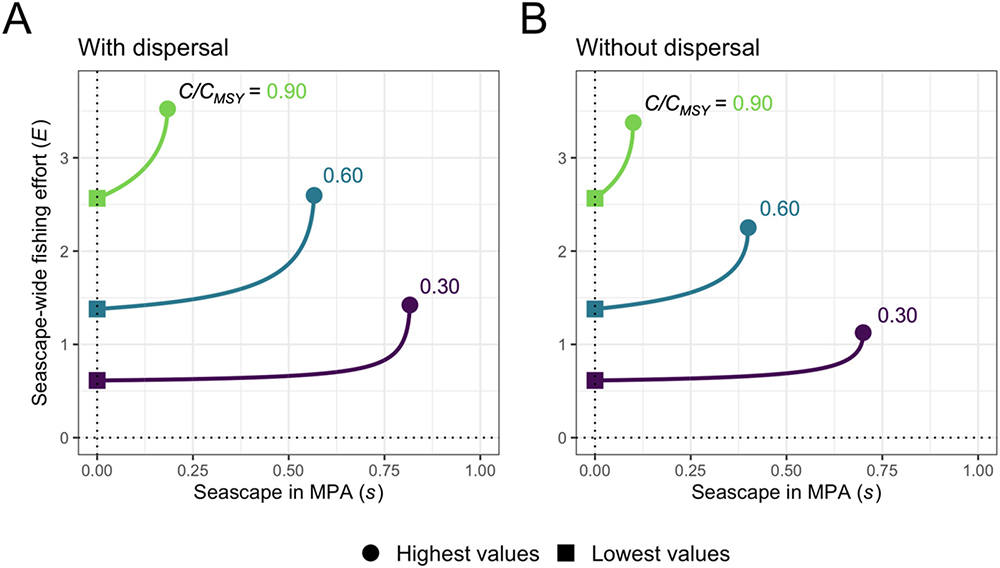
If there are highly sensitive species present in a seascape beyond those considered in our assemblages, or which are capable of recolonizing regions where they were previously eliminated by fishing, then sparing is likely to prove more beneficial than estimated here. Conversely, if such sensitive species are completely absent or unlikely to recover over meaningful timescales, then remnant species that do show resilience to fishing may be expected to benefit most from sharing.
All of our findings are subject to important limitations. Several of these – such as the lack of age structure, potentially vulnerable bony or cartilaginous fish in our species assemblages, trophic interactions, trawling-induced habitat damage, or stochasticity in our model – might, if addressed, generally be expected to favor MPAs. Conversely, we assume that effort is uniformly distributed across the entire seascape, which precludes there being unfished refugia if there are no MPAs. If instead we were to assume spatial heterogeneity in the distribution of fishing effort and the distributions of non-targeted species’ abundances, we suggest this would tilt our findings towards effort control alone.
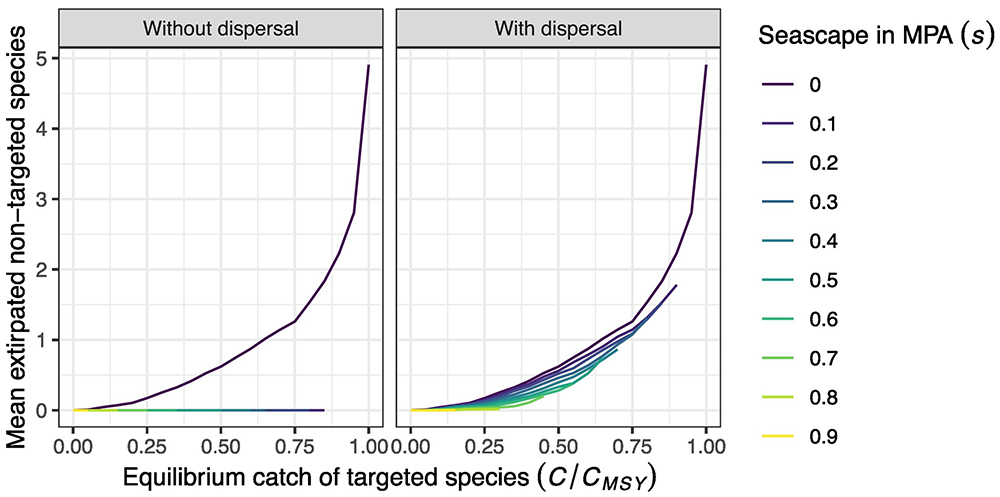
In our analysis MPAs are strongest when they are required to prevent the extirpation of a particularly vulnerable species; if natural refugia confer implicit protection to such species then this benefit would probably be reduced. In this situation, MPA efficacy may then depend on two factors: the probability that a given non-targeted species requires an MPA to avoid extirpation, and the probability that its range overlaps with that of the targeted species. Predicting the latter is likely to be especially difficult due to the paucity of data concerning benthic biodiversity in many regions of the world. Estimating fishery footprints may be more easily achievable, however, with new tools like Global Fishing Watch and the recent publication of maps of trawl fishery footprints.
Moreover, we only model conventional fisheries management as top-down effort control, ignoring other approaches within its scope. Improved technology, incentives, gear restrictions, and other interventions may all reduce the biodiversity impact of trawling under conventional fisheries management. Such interventions do come with attendant costs, however, whether in research, implementation, or lower catchability of the targeted species. Furthermore, while carefully tailored gear improvements have successfully reduced bycatch of high-profile taxa like turtles and marine mammals, adapting bottom trawling gear to dramatically mitigate its impacts on large numbers of poorly-known but vulnerable benthic and epibenthic organisms may be much more challenging.
Perspectives
Recent efforts to increase the global MPA estate make evaluating their effects on food provisioning and biodiversity critically important. By introducing the MacKay Principle to fisheries in the non-overfished case through a sea sparing/sharing framework, we find that the effects of MPAs on biodiversity may hinge on the incidence of highly sensitive species in seascapes and the metrics used to evaluate biodiversity.
If such species are present and metrics are used that value their persistence, many fisheries might maintain catches at least cost to biodiversity through the inclusion of MPAs alongside effort control. If such species are entirely absent, or if metrics like arithmetic mean abundance are used to measure biodiversity instead, then effort control alone may be best.
Further work should thus be conducted to determine the sensitivity of large numbers of non-targeted species to fishing. Moreover, analyses should be performed that incorporate phenomena not explored here, like trophic interactions and the costs of implementing each approach. MPAs and effort regulation have often been held up as rival strategies; in bringing the MacKay Principle to marine ecosystems through a sparing/sharing framework, we show that both may have merit depending on a seascape’s ecological and social context.
Now that you've reached the end of the article ...
… please consider supporting GSA’s mission to advance responsible seafood practices through education, advocacy and third-party assurances. The Advocate aims to document the evolution of responsible seafood practices and share the expansive knowledge of our vast network of contributors.
By becoming a Global Seafood Alliance member, you’re ensuring that all of the pre-competitive work we do through member benefits, resources and events can continue. Individual membership costs just $50 a year.
Not a GSA member? Join us.
Author
-
Philip Erm, M.Sc., University of Cambridge
Corresponding author
Conservation Science Group, Department of Zoology, University of Cambridge, Cambridge CB2, UK
Tagged With
Related Posts
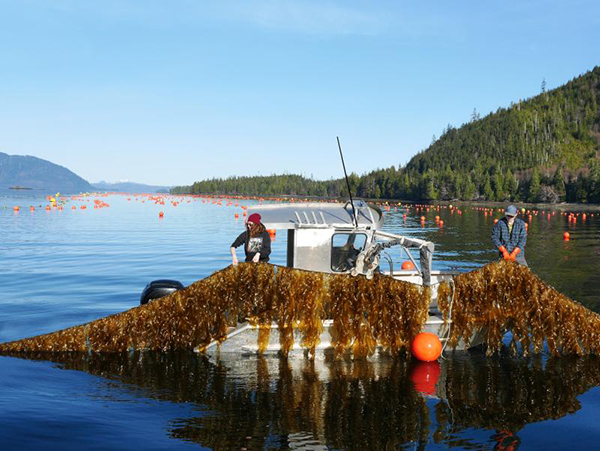
Innovation & Investment
Alaska Mariculture Cluster awarded grants to advance Alaska’s mariculture industry
The Alaska Mariculture Cluster has won nearly $49 million in grants to support Alaska's big-potential mariculture industry.
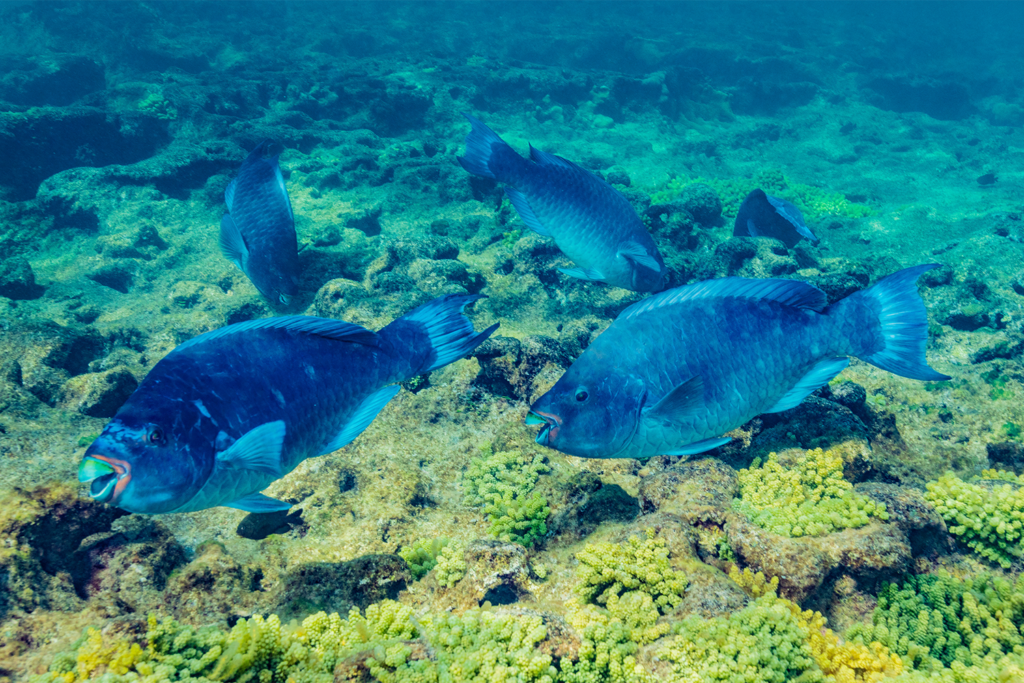
Fisheries
An inverted management strategy allowing limited fishing of endangered marine fish species in marine protected areas
If implemented correctly, endangered species would recover in the larger areas outside MPAs and fishers would benefit from the conservation value.
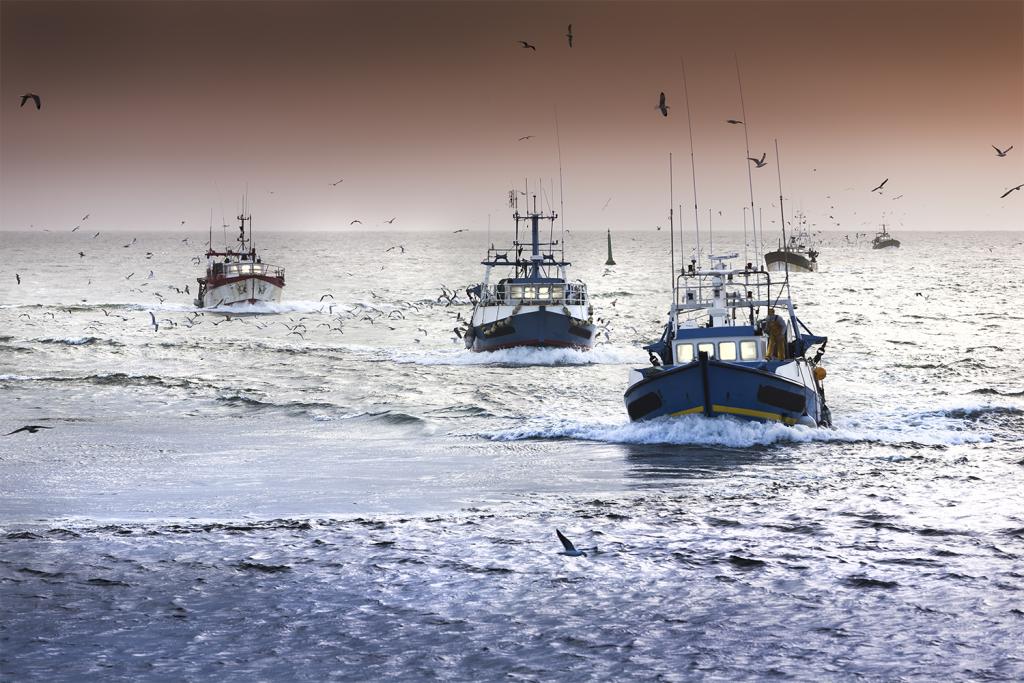
Innovation & Investment
‘We want change’: How a seafood database aims to influence seafood investment decisions
Planet Tracker’s seafood database evaluates seafood companies’ exposure to sustainability risks like overfishing and IUU fishing.

Responsibility
GSSI furthers its mission of clarity out of confusion
The Global Sustainable Seafood Initiative aims to set the bar for certification schemes. Board members of the task force formed in 2012 convened at the SeaWeb Seafood Summit in Malta to reinforce the mission and brief attendees on progress.



